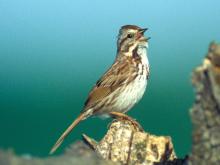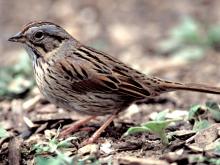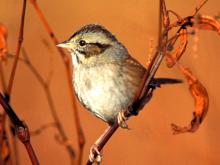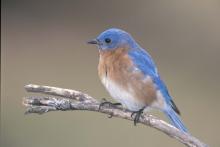Birds
Media

Species Types
Scientific Name
Dolichonyx oryzivorus
Description
The male bobolink is the only North American bird that has light feathers above and dark feathers below. In fall and winter, the male resembles the buffy and brown-streaked female.
Media

Species Types
Scientific Name
Melospiza melodia
Description
The song sparrow is an uncommon nester but a common winter resident throughout Missouri. You can find the song sparrow along forest edges and in many backyards.
Media

Species Types
Scientific Name
Melospiza lincolnii
Description
Lincoln's sparrow is small and shy, with fine streaks on its breast. In late fall and early spring, look for them along prairie edges and at bird feeders.
Media

Species Types
Scientific Name
Passerculus sandwichensis
Description
Savannah sparrows live in open habitat with nearby dense cover. In Missouri, we see them during migration and winters, but not summers.
Media

Species Types
Scientific Name
Melospiza georgiana
Description
The swamp sparrow is an uncommon winter resident in most of Missouri, but as the name indicates it may be more easily found in wet areas.
Media

Species Types
Scientific Name
Junco hyemalis
Description
Dark-eyed juncos, or "snowbirds" as they are widely known, are sparrows. Juncos are abundant throughout Missouri during the winter. What many people are not aware of is that there are two color forms of juncos that occur here.
Media

Species Types
Scientific Name
Sialia sialis
Description
The eastern bluebird is the state bird of Missouri. Many say its song sounds like “Cheer cheerful charmer.” The male has blue upperparts and rusty and white underparts.
Media

Species Types
Scientific Name
Actitis macularius
Description
The spotted sandpiper is one of our best-known shorebirds, with its spotted breast, orange bill, unique teetering, tail-bobbing gait, and enormous breeding range.
Media

Species Types
Scientific Name
Pheucticus ludovicianus
Description
The rose-breasted grosbeak's song is a beautiful, robin-like carol. Grosbeaks are chubby birds with heavy bills used for gathering and eating beetles, seeds, and fruits.
Media

Species Types
Scientific Name
Pluvialis dominica
Description
The American golden-plover is a robin-sized shorebird that makes an incredible annual odyssey from Argentina to the Arctic tundra, a distance of over 20,000 miles. It flies through Missouri in spring.
See Also







Media

Species Types
Scientific Name
Hemaris diffinis
Description
The snowberry clearwing is a moth that confuses people because it looks like a bumblebee and flies like a hummingbird!
Media

Species Types
Scientific Name
Hyles lineata
Description
The white-lined sphinx moth sometimes confuses people because it flies, hovers, and eats from flowers like a hummingbird. The adults often fly during daylight hours as well as in the night and are often found at lights.
Media

Species Types
Scientific Name
Darapsa myron
Description
The Virginia creeper sphinx moth is common in woods and brushy areas and comes to lights at night. The larvae eat Virginia creeper and grape leaves.
Media

Species Types
Scientific Name
Perimyotis subflavus (formerly Pipistrellus subflavus)
Description
Tri-colored bats, formerly called eastern pipistrelles, are relatively small and look pale yellowish or pale reddish brown. The main hairs are dark gray at the base, broadly banded with yellowish brown, and tipped with dark brown.
Media

Species Types
Scientific Name
Myotis grisescens
Description
Gray myotises are difficult to distinguish from other mouse-eared bats. A key identifying feature of the gray myotis is that its wing is attached to the ankle and not at the base of the toes. It’s an endangered species.
Media

Species Types
Scientific Name
Myotis lucifugus
Description
The little brown myotis (little brown bat) is one of our most common bats, but populations are declining. White-nose syndrome has taken a heavy toll in northeastern states. This species is now listed as vulnerable across its range.
Media

Species Types
Scientific Name
Myotis sodalis
Description
The Indiana myotis, or Indiana bat, summers along streams and rivers in north Missouri, raising its young under the bark of certain trees. It is an endangered species.
About Birds in Missouri
About 350 species of birds are likely to be seen in Missouri, though nearly 400 have been recorded within our borders. Most people know a bird when they see one — it has feathers, wings, and a bill. Birds are warm-blooded, and most species can fly. Many migrate hundreds or thousands of miles. Birds lay hard-shelled eggs (often in a nest), and the parents care for the young. Many communicate with songs and calls.





















